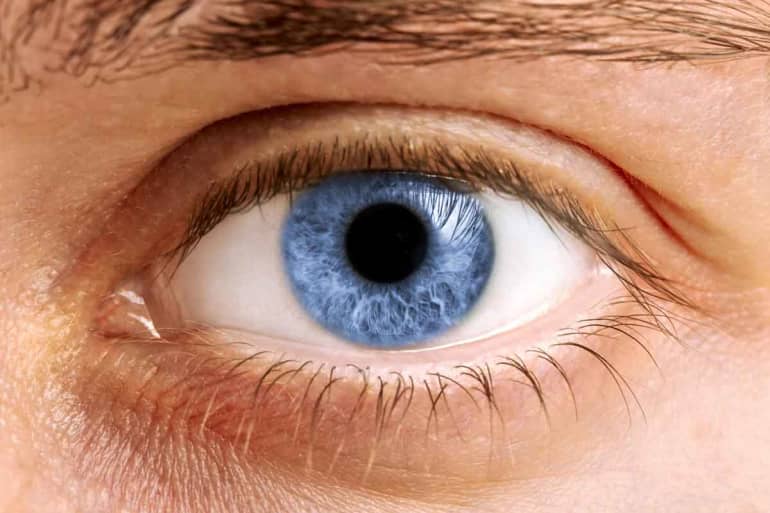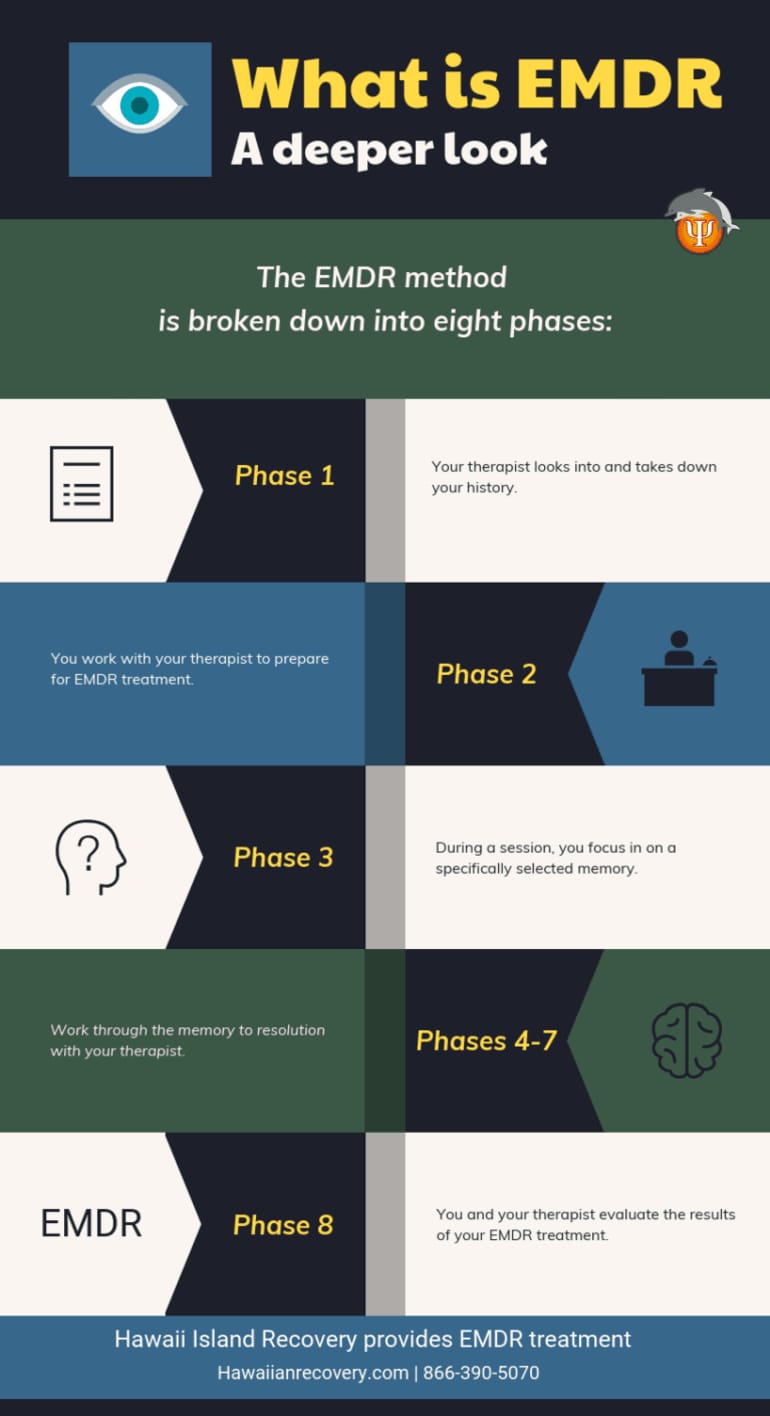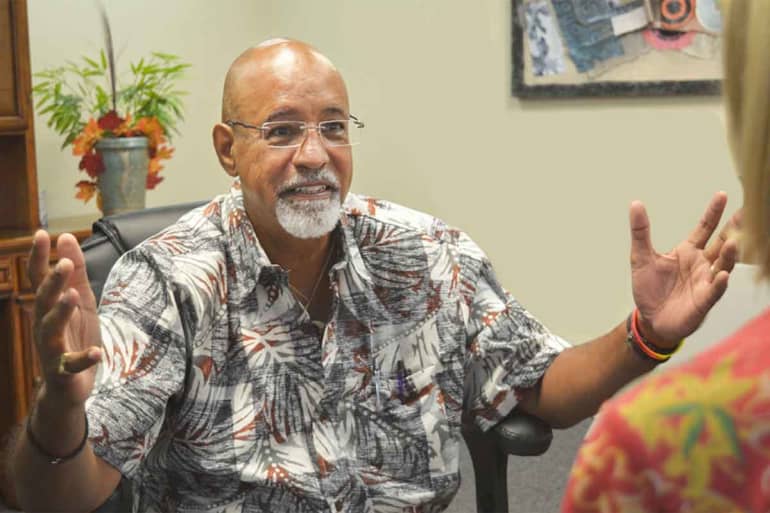What is EMDR Therapy? Of all the essential treatment services that are found in a high-quality drug treatment program, none are as important as therapy. Whether done in an individual or group setting, therapy helps bolster a client’s mental health, lessens the anxiety and panic attacks that can occur in treatment, and importantly addresses the underlying roots of their addictive behavior.
An effective form of therapy found in many treatment centers — including Hawaii Island Recovery
What is EMDR?
Eye movement desensitization and reprocessing therapy, or EMDR, is a form of psychotherapy. Developed by Francine Shapiro in the late 1980’s, EMDR therapy focuses specifically on helping people work through traumatic events and the resulting memories. When a person experiences something that is traumatic and do not process it properly, the impact of that event continues throughout their life. If left unresolved, people may turn to drugs and alcohol in order to cope.

Shapiro’s EMDR reprocessing therapy encourages helps the brain to work through these events and “reprocess” them. This settles many beliefs and behaviors that are developed as a result of not processing them in a healthy manner.
To understand what is EMDR, it helps to know how a session works. With the help of an experienced EMDR therapist, clients will target specific memories that cause present-day emotional distress. The client will place their focus on one memory at a time. EMDR therapy utilizes visual cues, such as the therapist’s hand, pointer finger, or a light board, to stimulate the brain while sitting with the memory. Some EMDR therapists choose to use sensory cues, like tapping, or audio cues through a headset.
The visual, physical, or auditory stimulation encourages the rewiring process in the brain. The therapist checks in with the client between “sets” of cues to see how the client perceives the memory. It usually takes between one and three sessions of treatment to work through one of the client’s traumatic memories.

A Deeper Look
You have a brief understanding of what is EMDR. How does a course of treatment with eye movement desensitization and reprocessing work? There are guidelines for therapists to follow when taking you through a course of EMDR treatment.

The method is broken down into eight phases:
- Phase 1: Your therapist looks into and takes down your history.
- Phase 2: You work with your therapist to prepare for EMDR treatment.
- Phase 3: During a session, you focus in on a specifically selected memory.
- Phases 4-7: Work through the memory to resolution with your therapist.
- Phase 8: You and your therapist evaluate the results of your EMDR treatment.
You work through each phase of treatment for each memory you need to target. The process is solution-oriented and does not focus on the trauma for longer than necessary. A therapist’s goal using EMDR is to reach a resolution as efficiently as possible.
When Does EMDR Work Best?
EMDR therapy is utilized to help people plagued by their traumatic memories. This form of therapy is particularly effective in those clients suffering from post-traumatic stress disorder. It is estimated that 70 percent of people experience some type of traumatic experience in their lives. 20 percent of these people develop post-traumatic stress disorder (PTSD) as a result. The symptoms of PTSD range from mild to severe depending on the person. Some are so entirely debilitated by their symptoms and have difficulties leaving the house.

When disturbing memories leave a lasting impact and the person develops PTSD, therapists often turn to EMDR to help. Through working together, the individual and their therapist process through difficult memories. As they work through each, they find their symptoms decrease over time to the point they no longer struggle with PTSD.

Hawaii Island Recovery offers 3 powerful evidence-based treatment therapies as part of the well-rounded approach to your treatment.
More infoHow Effective is EMDR?
The length of EMDR treatment depends on how long your behaviors and beliefs continue for. The more deeply ingrained your memories are, the longer treatment lasts. Depending on how many memories you must work through, treatment may take up to a few months.

Still, research shows that in 84 to 90 percent of cases, it takes between one and three sessions to process through a memory. Many therapists see EMDR as an effective form of treatment for those who struggle with the impact of their traumatic past.
In one study, 77 percent of war veterans found freedom from PTSD symptoms after 12 sessions. In another study, 100 percent of people with a single traumatic experience no longer struggled with PTSD after six sessions.
Is EMDR good therapy?
Over the past few years, there has been increased attention focused on an emerging therapy called Eye Movement Desensitization and Reprocessing Therapy (EDMR). Developed in the late 1980’s, EDMR involves patients recalling traumatic events in their lives while moving their eyes back and forth. Therapists help clients redirect eye movements, so these traumatic memories slowly integrate into their normal memories. Over time, it is believed that repeated exposure to traumatic memories lose their effect.

There has been a growing body of studies that are showing that EDMR Therapy can be an effective tool in helping people who suffer from anxiety, chronic pain, PTSD, depression and a wide range of phobias. While these studies are encouraging, the biggest question regarding EDMR is if it is a good therapy. The following are reasons why EDMR is good therapy.
Change Self-Belief
Much like CBT, EDMR therapy aims to find negative self-thinking and beliefs that keep people stuck in past trauma. Through guided eye movement exercises, EDMR helps people to take away the power of negative memories. Instead of dwelling on negative connotations, people in this therapy can learn to find more meaningful interpretations of these memories that will help them grow.
Help Recover from Trauma
EDMR therapy engages both sides of the brain. As a result, it helps people process traumatic memories in a healthy way. In addition to PTSD, anxiety and depression, EDMR can help people who struggle with the memories of events such as bullying, nightmares and divorce.
Quicker Path to Success
The unique aspect of EDMR is the fact that it isn’t talk based. In other therapies which are talk-based, people may have problems vocalizing the hurt they feel. In EDMR, people are not required to talk about their particular traumatic event or issue. This can result in shorter therapy duration and with tangible results.
Stress Management
EDMR is great therapy in the fact that people will learn to handle stresses that arise in the daily lives before they get worse. People are able to schedule “brush up” EMDR therapy sessions to help them navigate the anxiety and stress they may be feeling about
a current situation.
Self-Improvement
A long-lasting benefit of EDMR therapy is that people can continually learn and grow. The whole point of this therapy is to transform negative thoughts and beliefs into positive ones. This transformative thinking spills over into relationships, work, health and much more. Through EDMR, you are able to empower yourself to change your life.
As you can see, there are great benefits that can be found with EDMR therapy. If you or a loved one are struggling with issues and feel intimidated by traditional therapy, EDMR is worth a deeper look.
Get Addiction Treatment
If you or a loved one need help, call Hawaii Island Recovery toll-free right now.
866-390-5070 Hawaii Island Recovery
Hawaii Island Recovery 










